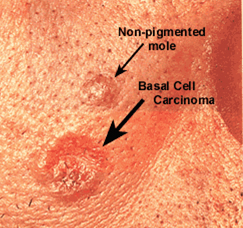There are four cancers that may be found on the eyelids: basal cell carcinoma, squamous cell carcinoma, melanoma, and sebaceous cell carcinoma. Basal cell carcinoma is the most common eyelid cancer and sun exposure is the largest risk factor.
All suspicious eyelid bumps should be examined by a physician. Signs that indicate that the bump may be cancer is increasing size, changing color, bleeding, scabbing, or crusting.
 Your physician will likely take a biopsy of the suspicious bump and send it to a laboratory for examination. If it turns out to be cancer and if not all of it was removed during the biopsy, it will be necessary to go back and excise all of the tissue invaded by the cancer.
Your physician will likely take a biopsy of the suspicious bump and send it to a laboratory for examination. If it turns out to be cancer and if not all of it was removed during the biopsy, it will be necessary to go back and excise all of the tissue invaded by the cancer.
Once all the cancer has been meticulously excised, you may need one or more additional procedures to reconstruct the eyelid and restore normal function. In rare cases, it may be necessary to work with other physicians such as dermatologists or oncologists to ensure sufficient and complete treatment.


